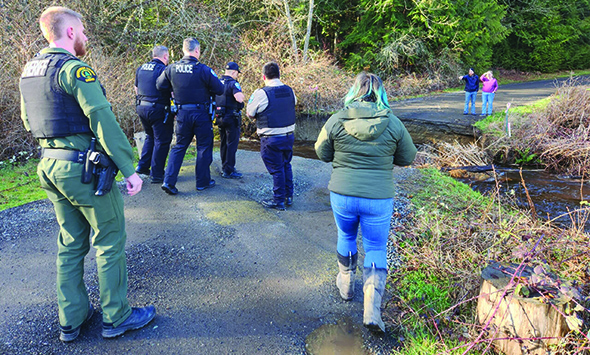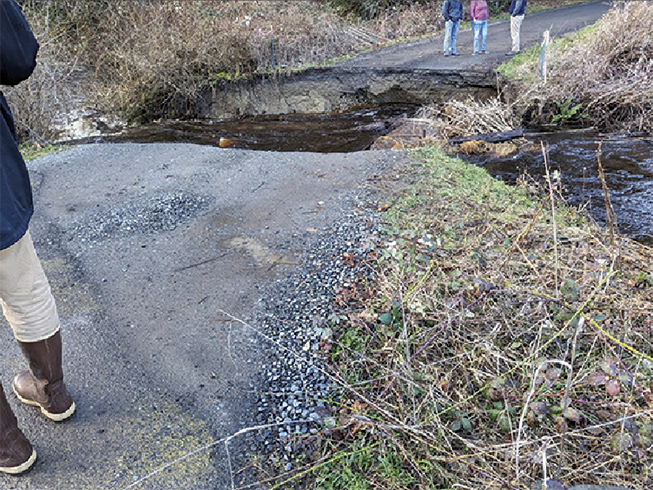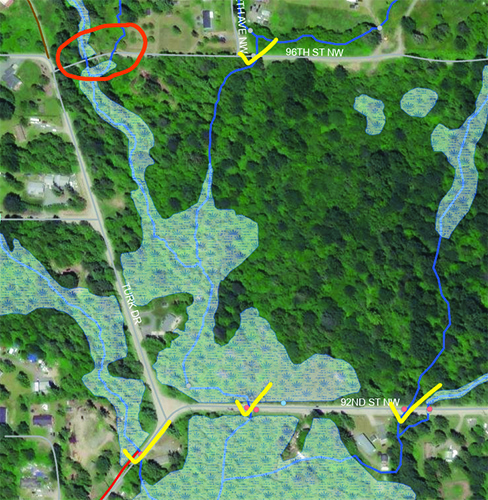
By Kalvin Valdillez, Tulalip News; photos courtesy of Tulalip Tribes Natural Resources
Last week, we saw problematic journalism about Tulalip by the King 5 media team. The story highlighted a culvert and road collapse on 12th Avenue NW, within the Battle Creek neighborhood on the Tulalip reservation. The footage showed residents of the Aqua Hills Homeowners Association blaming the Tribe while simultaneously asking for the Tribe’s assistance to remedy the issue.
On the afternoon of March 1, heavy rainfall led to flooding which caused a decrepit culvert and the private road above it to wash out. The angle the media team chose to take was, of course, sympathetic to the approximate 20 affected families. However, they neglected to provide context. Tulalip has a long history of offering help and being turned away by Aqua Hills residents. The Tribe responded to this situation immediately, ensuring the residents were safe and had drinkable water, despite being met with hostility by the HOA on numerous occasions.

Moving forward in this article, it is important to understand that the Tulalip Tribes has zero responsibility in the maintenance of 12th Avenue NW. Although the road and the neighborhood are located within the boundaries of the Tulalip reservation, this is a privately owned and operated road, and its proper care and upkeep is the sole responsibility of the Aqua Hills HOA.
This particular instance is a prime example of how Native sovereignty is consistently undermined and exploited by non-Natives who choose to buy property and reside on reservations all throughout the country, without acknowledging or following any of the respective tribe’s laws, rules, or regulations.
The Tribe issued a detailed media release pertaining to the collapse on March 5, which explained that back in 2013, Tulalip notified the HOA that the culvert which caused the flood was inadequate and needed to be replaced. The Tribe also expressed an interest in working together with the HOA to get a properly sized culvert installed. The HOA did not share the same interest at the time and failed to take action following the Tribe’s initial recommendation.
Nine years later, in 2022, the Aqua Hills HOA reached out to the Tribe and asked for their help in removing beavers in their area through Tulalip’s beaver relocation project. After agreeing to relocate the beavers living along the Battle Creek marshes, the Tribe’s Natural Resources Department was met with conflict as one of the HOA property owners denied them access to their land and threatened to take legal action if the Tribe continued with the relocation effort.
The media release also spoke about how the Tribe has been on the scene and made a handful of their various departments available to assist with the road closure, whether that’s through surveying the damage, restoring potable water to the residents, or ensuring that the homeowners are not physically trapped within the enclosed area.

Out of the entire detailed media release, King 5 chose to share just one section of it in their article about 12th Avenue NW:
“The non-native residents are asking Tulalip to replace private infrastructure that is the homeowners’ responsibility, at the Tribe’s expense, and for the benefit of a handful of landowners…Tulalip will continue to work with the HOA to arrive at a quick and effective solution to this crisis because of the Tribes’ values.”
Let’s spend a second here because balanced journalism, which shares both sides of story, is important especially when dealing with tribal sovereignty. This statement, although true, was altered to villainize the Tribe and help push the homeowner’s narrative that it’s the Tribes obligation to fix the culvert and road. In total, four paragraphs that explained how the HOA got themselves in this predicament and burnt bridges with the Tribe were ignored and not mentioned whatsoever in the article. And the portion that was included, has key statements missing, that ultimately misleads readers about the situation. The original statement reads as follows, with the sentences that were excerpted in italics:
“Tulalip neither owns nor collects taxes to maintain these parcels. The non-native residents are asking Tulalip to replace private infrastructure that is the homeowners’ responsibility, at the Tribe’s expense, and for the benefit of a handful of landowners. They have been aware of the vulnerability for a decade and have not addressed the issues that led to this problem. Tulalip will continue to work with the HOA to arrive at a quick and effective solution to this crisis because of the Tribes’ values – not because it has a responsibility to rectify problems caused by private non-member landowners.”
It is upsetting that a Tribe that has done so much good throughout the region, that has consistently given back and has routinely helped build up the local community, were portrayed as negligent, unwilling to help, and at fault for the incident on 12th Ave NW, when in fact it is the complete opposite of the situation.
This is dangerous because the news station is making a conscience decision to exclude the Tribe’s voice on a story where they were attacked on-air and in-print, regardless of their efforts to help these individuals and families over the past 11 years.
Since King 5 chose to silence Tulalip leadership and those who are monitoring the road closure closely, we wanted to share their perspective in this article, where they can provide insight to the collapse of 12th Ave NW.
Teri Gobin, Tulalip Chairwoman
12th Avenue NW is a privately owned road. The Tribe does not own it and we do not have any responsibility to fix it. What happened there is a private owner of the land had a culvert there, that was undersized. And actually, our natural resource people told them years ago, that it was failing, that they should do something about it. The owner of it told us that the Tribe had no jurisdiction, being it was on his private land, and asked us to leave.
If this were to happen two weeks later, it would have wiped out a chum run. We were getting ready to bring our fingerlings down there. It would have wiped out that run, and who’s responsibility would that have been?
They have been warned that this culvert was bad. And they did nothing about it.
They don’t want anything to do with the Tribe until when they need the Tribe, and they think the Tribe will take care of that. It’s not our responsibility.
Carson Cooper, Tulalip Managing Attorney
We have a mix in the types of roads that are located here on the reservation. There are really three types. There are roads that are maintained and owned by Snohomish County. There are tribal roads that are owned and maintained by Tulalip Tribes. And then there are private roads, which are roads that individual communities have decided they want to restrict access to.
The road that goes over Battle Creek is a private road. It’s the responsibility of Aqua Hills Homeowners Association. What that means is that they are responsible for maintaining both the road and the culvert. They originally funded that road. They did the construction. They put in the culvert without the involvement of Tulalip Tribes, and they’re responsible for maintaining it and making sure it’s in good shape.
Ryan Miller, Tulalip Director of Treaty Rights and Government Affairs
I think it’s really important for people to understand that originally, reservations were set aside for tribes, and they were collectively owned by the tribal government. It wasn’t until the allotment era that those reservations were broken up into individual Indian allotments. And that’s how we ended up in this situation, that we have with checkerboard reservations. There are examples of Indian women who had an allotment, and they received some kind of government funding, and the government said you can’t be a property owner and receive welfare from the state, so now you have to sell your property and pay it back. There are lots of different times when the BIA, that’s supposed to hold that land and trust for the benefit of tribal members, mismanaged the money, mismanaged the land, leased the land to be logged or mined, or some other use, and never gave the money to that person. And that person ended up having to sell the land. That created the start of this adversarial relationship between non-Indian people and Indian people on the reservation. And as Snohomish County got bigger, those jurisdictional questions expanded. Environmental rules and permitting for homes and things like that, that didn’t exist prior, became more and more of a problem.
When we have a catastrophic event like this, especially if there are fish in the water, one of the number one things that we worry about is turbidity. So, you get a lot of sediment stirred up in the water, it becomes a part of the water column and fish can get that into their gills and it kills them. So that’s kind of the number one immediate threat. And also, there’s the threat of this large volume of water coming out all at one time, which could push the fish out into the saltwater before they’re ready. Which could again kill them because they need time to adjust. They need to get in that mixture of salt and freshwater, and they go through some physical changes in their scales that helps protect them from saltwater, it’s part of the biology of anadromous fish.
So, those are the immediate threats. And then the long-term threats are – if this culvert doesn’t get repaired properly, it could cause significant water quality challenges into the future for temperature, for flows, depending on if there may be chemicals or other things within the structure that could cause problems downstream. Those are kind of the main risks. And until it’s fixed, we can’t put fish in this facility, because there’s always the threat that the culvert itself could move downstream. It could have significant impacts on the lungs of fish, of their gills. It could burn them, it could burn their skin, it could delay or inhibit their ability to go through the smelting process which is what they need to do in order to get into the saltwater.
Sam Davis, Tulalip Tribes COO
We had a culvert fail. That happened around 3:00 p.m. or 4:00 p.m. on Friday and we responded through most of the night. We had our emergency management there, Snohomish County emergency management there, so we had the all the response teams ready to go.
It had a very big impact on Battle Creek and flooded out our chum hatchery. We do have a major chum hatchery downstream, so our gauges that are in Battle Creek went off the chart. We had four to six feet of excess water above where it normally is, so that was really where our strategy was, to look at our areas downstream.
As a Tulalip member and a lifelong citizen up of Tulalip, it’s been disturbing to look in the news media and have these people pointing their fingers at Tulalip like we’re somehow to blame for their lack of maintenance on their asset and their inventory in the road.
We would like to be good neighbors, but when somebody is bad mouthing us that much in the in the media, in the press, it hurts a little bit, and it makes us a little angry. It’s pretty simple – this is the private road owned by an HOA. It’s laid out in a legally binding document. And now that they don’t have anywhere to go, they want to point fingers at us, and that’s the wrong thing to do.